Objective: From a time-series df, make a plot of each occurrence of a particular state (or factor level) with x timepoints before, and y timepoints after, the onset (i.e. first row) of that state. The graph should be centered on zero (on the x-axis), such that the x timepoints before the event are negative values, and the y timepoints after the event are positive values. This is the same principal as a peristimulus time histogram.
The data: I have time-series data where different states can occur for variable amounts of time. First I use run length encoding (rle) to determine the start and stop of each run of each state (not shown). Second, I use a function, similar to the one described here, to return, say one row above and two rows below the onset of a particular state (state "A" in the example below). Here’s what that data looks like.
df <- data.frame(
state = c("A","A","A","A","A","B","A","A","X","Y","Z","A","A","A","B","A","A"),
start = c("start","NA","NA","NA","NA","NA","start","NA","NA","NA","NA","start","NA","NA","NA","start","NA"),
rleGroup = c("1","1","1","1","1","2","3","3","4","5","6","7","7","7","8","9","9"),
data = runif(17)
)
df <- df %>% tidyr::unite(stateStart, c(state,start), sep = ".", remove = FALSE)
stateStart state start rleGroup data
1 A.start A start 1 0.85118187
2 A.NA A NA 1 0.23502147
3 A.NA A NA 1 0.97435662
4 A.NA A NA 1 0.45669042
5 A.NA A NA 1 0.48271803
6 B.NA B NA 2 0.80561653
7 A.start A start 3 0.27228361
8 A.NA A NA 3 0.07008506
9 X.NA X NA 4 0.44101076
10 Y.NA Y NA 5 0.95173954
11 Z.NA Z NA 6 0.65693316
12 A.start A start 7 0.45831802
13 A.NA A NA 7 0.83629347
14 A.NA A NA 7 0.62107270
15 B.NA B NA 8 0.53294588
16 A.start A start 9 0.08533221
17 A.NA A NA 9 0.28805362
extract.with.context <- function(x, colname, rows, after = 0, before = 0) {
match.idx <- which(x[[colname]] %in% rows)
span <- seq(from = -before, to = after)
extend.idx <- c(outer(match.idx, span, `+`))
extend.idx <- Filter(function(i) i > 0 & i <= nrow(x), extend.idx)
extend.idx <- sort(unique(extend.idx))
return(x[extend.idx, , drop = FALSE])
}
extracted = extract.with.context(x=df, colname="stateStart", rows=c("A.start"), after = 2, before = 1)
stateStart state start rleGroup data
1 A.start A start 1 0.85118187
2 A.NA A NA 1 0.23502147
3 A.NA A NA 1 0.97435662
6 B.NA B NA 2 0.80561653
7 A.start A start 3 0.27228361
8 A.NA A NA 3 0.07008506
9 X.NA X NA 4 0.44101076
11 Z.NA Z NA 6 0.65693316
12 A.start A start 7 0.45831802
13 A.NA A NA 7 0.83629347
14 A.NA A NA 7 0.62107270
15 B.NA B NA 8 0.53294588
16 A.start A start 9 0.08533221
17 A.NA A NA 9 0.28805362
The problem: I want to plot each extracted run of state A (i.e., one timepoint before and two timepoints after A.start). One thought is to make a unique identifier for each run grouping of state "A" (Question 1), and then make a time sequence counter that reflects the desired rows before and after the onset of state A (Question 2).
QUESTION NUMBER 1. Create a unique identifier for each "plotGroup", defined as each run of state A (i.e., a row before A.start and two rows after A.start) I tried this, but it's not quite working
extracted %>% mutate(plotGroup = cumsum(lag(state) == "A" & state != "A"))
it should look like this
extracted$plotGroup <- c("0","0","0","1","1","1","1","2","2","2","2","3","3","3")
stateStart state start rleGroup data plotGroup
1 A.start A start 1 0.85118187 0
2 A.NA A NA 1 0.23502147 0
3 A.NA A NA 1 0.97435662 0
6 B.NA B NA 2 0.80561653 1
7 A.start A start 3 0.27228361 1
8 A.NA A NA 3 0.07008506 1
9 X.NA X NA 4 0.44101076 1
11 Z.NA Z NA 6 0.65693316 2
12 A.start A start 7 0.45831802 2
13 A.NA A NA 7 0.83629347 2
14 A.NA A NA 7 0.62107270 2
15 B.NA B NA 8 0.53294588 3
16 A.start A start 9 0.08533221 3
17 A.NA A NA 9 0.28805362 3
QUESTION NUMBER 2. Create a "counter," centered on zero, of one row above and two rows after the A.start This I have no idea how to do! But presumably can make use of "span" in the function This is my desired output
extracted$span <- c("0","1","2","-1","0","1","2","-1","0","1","2","-1","0","1")
stateStart state start rleGroup data plotGroup span
1 A.start A start 1 0.85118187 0 0
2 A.NA A NA 1 0.23502147 0 1
3 A.NA A NA 1 0.97435662 0 2
6 B.NA B NA 2 0.80561653 1 -1
7 A.start A start 3 0.27228361 1 0
8 A.NA A NA 3 0.07008506 1 1
9 X.NA X NA 4 0.44101076 1 2
11 Z.NA Z NA 6 0.65693316 2 -1
12 A.start A start 7 0.45831802 2 0
13 A.NA A NA 7 0.83629347 2 1
14 A.NA A NA 7 0.62107270 2 2
15 B.NA B NA 8 0.53294588 3 -1
16 A.start A start 9 0.08533221 3 0
17 A.NA A NA 9 0.28805362 3 1
Ultimate objective: plot data by span for each individual plotgroup
ggplot(data=extracted, aes(x=span, y = data, group = plotGroup)) + geom_line()
